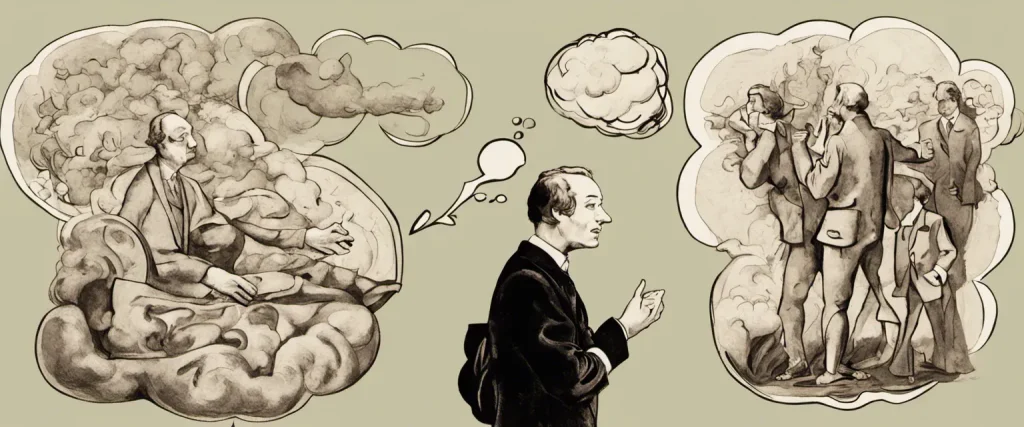In his thought-provoking book “Upheaval,” acclaimed historian Jared Diamond expertly dissects the factors that shape the destiny of nations and offers valuable insights into how countries navigate through moments of crisis. Drawing upon his extensive research and expertise in sociology, anthropology, and geography, Diamond brilliantly examines the patterns and lessons gathered from various nations across the globe. With his compelling narratives and compelling analyses, he empowers readers to understand the forces driving societal transformations and to contemplate the challenges facing modern civilizations.
Chapter 1: Introduction
Chapter 1: Introduction of the book “Upheaval” by Jared Diamond serves as an introductory exposition, outlining the main themes and thesis of the book. The chapter focuses on the concept of national crises and how countries navigate through them.
Diamond starts by posing the question of why some nations are successful in overcoming crises, while others succumb to them. He introduces the concept of political crises, which can be defined as a sudden, severe deviation from the usual functioning of a country that threatens its stability. Furthermore, he presents a framework for understanding how countries respond to these crises by examining twelve national case studies, including Finland, Germany, and Australia among others.
The author highlights that national crises can arise from various sources such as external conflicts, environmental challenges, and internal clashes. He emphasizes that the capacity of a nation to respond effectively to crises depends on factors like a shared national identity, honest self-appraisal, and the willingness to learn from past mistakes. Diamond posits that resilience plays a significant role in determining a country’s fate during a crisis.
Moreover, he identifies personal crises as a parallel concept. Individuals face challenges and personal crisis situations in a similar manner to countries, often requiring introspection, acknowledgment of weaknesses, and the ability to implement necessary reforms to ultimately achieve personal growth.
In conclusion, Chapter 1 of “Upheaval” offers an overview of the book’s central theme: the examination of national crises and the factors that determine a country’s successful recovery. Diamond sets the stage for the subsequent chapters, where he delves deeper into the specific case studies and further explores the patterns and lessons learned from these historical events.
Chapter 2: Identifying National Crises
Chapter 2 of “Upheaval” by Jared Diamond explores the concept of identifying national crises, using historical case studies to analyze different countries facing immense challenges in the past. Diamond begins by highlighting the importance of recognizing a crisis and distinguishing it from everyday issues or conflicts that nations typically face.
Diamond focuses on six key factors in identifying national crises: a conflict of values, a failure to respond to challenges, a group of powerful external enemies, legitimate internal dissent, environmental problems, and poor governance. The author argues that nations that have faced and successfully overcome these crises have done so by recognizing the existence of these challenges and taking appropriate actions.
Through case studies, Diamond illustrates how Finland, Japan, Chile, Indonesia, and Germany faced major crises and eventually managed to recover and transform themselves as a result. Each country had a unique set of challenges, such as territorial disputes, economic recessions, political turmoil, or environmental disasters, but they all managed to confront their crises head-on.
Diamond concludes by emphasizing the importance of learning from history and understanding the different trajectories nations can take when confronting national crises. He suggests that acknowledging these challenges and implementing necessary changes are vital for a nation’s renewal and survival.
In summary, Chapter 2 of “Upheaval” explores the identification of national crises by examining historical examples and highlighting the common factors that nations facing crises tend to exhibit. Diamond emphasizes the significance of recognizing significant challenges and implementing appropriate measures to address them, drawing on case studies to illustrate how countries have successfully navigated and overcome major crises in the past.
Chapter 3: Crisis Resilience
Chapter 3: Crisis Resilience of the book “Upheaval” by Jared Diamond explores the concept of crisis resilience, using examples from historical events and nations to analyze how societies handle major crises and adapt to avoid collapse.
Diamond begins the chapter by discussing personal crises and the resilience individuals need to overcome them. He then extends this concept to nations, stating that they too face crises, and their ability to respond effectively determines their long-term stability.
The author presents several case studies to illustrate this point. Firstly, he examines Finland’s response to the Winter War with the Soviet Union in 1939-1940. Despite being outnumbered and outgunned, Finland’s resilience and determination to defend their independence ultimately led to their survival and success. Diamond emphasizes the importance of a united national effort and highlights the Finnish people’s high degree of trust in their government and institutions as key components of their resilience.
Next, Diamond looks at Chile’s response to the 1973 coup by General Augusto Pinochet. He explains how the institutional strength and strong leadership of the military dictatorship contributed to their ability to navigate the crisis successfully. However, he also highlights the dark side of resilience, such as human rights abuses, which can accompany effective crisis management.
Diamond concludes the chapter by summarizing the factors that contribute to crisis resilience in a nation: a realistic appraisal of the crisis, acceptance of responsibility by elites, a strong national identity, competent bureaucracy, trust in government and institutions, and good leadership. In contrast, a lack of these factors can lead to a nation’s demise.
Overall, chapter 3 of “Upheaval” explores the concept of crisis resilience by analyzing historical cases. Diamond’s analysis sheds light on the factors and behaviors that determine a nation’s ability to withstand and overcome major crises.
Chapter 4: Crisis Response: Choosing Between Four Options

Chapter 4 of Jared Diamond’s book “Upheaval” explores the various options societies have when faced with a crisis. Diamond highlights four possible responses that nations can choose from: denial, muddling through, proactive change, and transformation.
Denial is a common response to crises, where societies attempt to simply ignore or downplay the problem. Countries that choose this option may be overly optimistic or suffer from a lack of information, leading to delayed reaction and exacerbation of the crisis.
Muddling through entails taking small, incremental steps to address the problem without major disruptions. This approach is often chosen when a society lacks a clear understanding of the issue or is constrained by political or economic factors. While it may seem like a practical solution, it can be inadequate for long-term resolution.
Proactive change involves recognizing the crisis and implementing bold and comprehensive measures to solve it. This option requires strong leadership and an informed public, as well as the willingness to address the root causes of the crisis. Proactive change can be successful, but it requires political will and collective action.
Transformation represents the most radical response to a crisis. It involves restructuring the entire society, its institutions, and its values in order to overcome the crisis. Transformation can be prompted by a catastrophic event or a realization that the existing system is fundamentally flawed. However, it is also the most challenging and disruptive option, as it requires a significant overhaul of the status quo.
Throughout the chapter, Diamond emphasizes that the most effective response to a crisis will depend on the specific circumstances and challenges faced by each society. He also highlights the importance of leadership, public awareness, and collective action in navigating and overcoming crises.
Chapter 5: National Identity and Social Cohesion
Chapter 5 of Jared Diamond’s book “Upheaval” delves into the complex topic of national identity and social cohesion. Diamond explores how countries’ collective consciousness and level of societal unity play a crucial role in their ability to overcome significant challenges and navigate through upheavals successfully.
First, Diamond emphasizes the importance of a shared national identity in fostering cooperation and collective action. National identity refers to a population’s sense of belonging and shared values, beliefs, and aspirations. Diamond suggests that a strong national identity can unite citizens, fostering cohesion and resilience in times of crisis. Conversely, a fragmented identity or deep divisions can hinder a nation’s ability to respond effectively to challenges.
The author then examines several case studies to illustrate these concepts. He looks at Finland’s ability to recover rapidly from the devastating Winter War against the Soviet Union and attributes it to the Finns’ strong national identity and common purpose. On the other hand, Diamond highlights the ongoing struggles of post-Soviet Russia due to its fractured national identity, which hampers efforts toward unity and progress.
Diamond also explores how external threats can sometimes bring about a sense of unity and cohesion within a nation. He cites the example of Japan’s response to the Meiji Restoration in the late 19th century, where the country’s leaders successfully united the population to modernize and regain strength against foreign encroachment.
In conclusion, Diamond asserts the significance of cultivating a strong national identity and social cohesion as crucial components for a nation’s ability to navigate upheavals successfully. National unity fosters resilience and collective action in times of crisis, while divisions and weak identity can hinder progress. Understanding the dynamics of national identity becomes vital to comprehending a nation’s response to challenges and identifying potential solutions.
Chapter 6: Choosing to Learn from Other Nations
Chapter 6 of Jared Diamond’s book “Upheaval” is titled “Choosing to Learn from Other Nations.” In this chapter, Diamond explores how countries can learn from the experiences and historical lessons of other nations to avoid making similar mistakes and ensure their long-term stability and success.
To begin, Diamond emphasizes the importance of acknowledging and overcoming a concept known as “asymmetry of diffusion.” It refers to the tendency for valuable information and innovations to spread slowly and inefficiently across countries, resulting in missed opportunities for progress. Diamond proposes that countries should actively seek and implement the successful policies and practices of other nations, rather than insisting on reinventing the wheel.
The author highlights various case studies to illustrate the benefits of looking to other nations for guidance. For instance, he discusses Japan’s post-World War II transformation, in which the country adopted Western practices and incorporated them into its own unique cultural context. Diamond also explores the cases of post-Soviet Finland, post-colonial Chile, and Australia’s reconciliation with its indigenous population. Each of these examples demonstrates the profound impact of learning from other nations and adapting their strategies to fit local circumstances.
Furthermore, Diamond introduces the concept of “collective learning” and argues that it is crucial for countries to engage in open dialogue and knowledge sharing with others. By facilitating the free exchange of ideas, nations can create a collaborative environment that encourages mutual learning and growth.
In summary, Chapter 6 of “Upheaval” emphasizes the significance of learning from the experiences of other nations. Diamond highlights the importance of overcoming asymmetry of diffusion, showcases successful case studies, and emphasizes the need for collective learning. By embracing the wisdom and lessons of other countries, nations can improve their chances of achieving stability and prosperity.
Chapter 7: Learning from Other Nations
Chapter 7 of “Upheaval” by Jared Diamond, titled “Learning from Other Nations,” examines the concept of national rejuvenation by drawing lessons from the historical experiences of six diverse countries – Finland, Japan, Germany, Chile, Indonesia, and Australia. Diamond explores how these nations confronted and successfully overcame major crises by critically analyzing their systems of self-appraisal, crisis management, and collective learning.
Diamond emphasizes the significance of national self-appraisal as a fundamental prerequisite for addressing and resolving crises. He highlights Finland’s ability to acknowledge its reliance on the Soviet Union and subsequently transform its industrial base and global involvement after the collapse of the USSR. Similarly, Japan’s post-World War II self-examination led to a collective resolve to overcome their economic downturn by prioritizing technological advancement and innovation.
The author also examines Germany’s remarkable transformation post-World War II, where a comprehensive process of self-reflection helped the nation overcome its burdened historical legacy and adopt a proactive role in promoting international stability and peace.
Additionally, Diamond delves into the challenges faced by Chile and Indonesia as they confronted political and social crises. Factors such as willingness to confront painful historical realities, establishing truth commissions, and promoting national reconciliation enabled these nations to pave the way for a brighter future.
Australia’s ability to address its problematic treatment of indigenous populations, reassess its relationship with Asia, and recognize the urgent need to address climate change serves as an example of a nation successfully confronting major challenges and implementing fundamental changes.
Throughout the chapter, Diamond emphasizes the importance of not only recognizing crises but also having a collective determination to learn from them and embrace necessary changes. The experiences of these nations highlight the potential for rejuvenation and progress through self-appraisal, learning from history, and implementing transformations.

Chapter 8: Applying Lessons to the Future
Chapter 8 of “Upheaval” by Jared Diamond, titled “Applying Lessons to the Future,” delves into the author’s reflections on how the lessons learned from past crises can guide us in navigating the challenges of the future. Diamond draws upon his extensive research on historical case studies of nations that have faced severe crises and examines what factors contributed to their resilience or downfall.
In this chapter, Diamond emphasizes the importance of taking a proactive and learning-based approach to the future. He highlights the significance of having national identities and shared values that unify individuals in times of crisis. National identity can provide motivation for citizens to make sacrifices for the collective good. The author argues that a sense of a common destiny and purpose is crucial for national recovery from crises.
Diamond also stresses the value of acknowledging and overcoming national biases and addressing long-standing societal problems. By recognizing and confronting divisive issues like racial and ethnic tensions, inequality, and corruption, countries can foster unity and strengthen social cohesion.
Additionally, the author emphasizes the importance of planning for potential future challenges. By anticipating and addressing likely crises in advance, nations can implement measures to mitigate their impact. Diamond cites examples of countries, such as Finland and Chile, that successfully navigated past crises through rigorous planning and proactive decision-making.
In summary, Chapter 8 of “Upheaval” underscores the importance of drawing lessons from historical examples to shape a more resilient and prosperous future. By cultivating a strong national identity, addressing underlying societal issues, and actively preparing for future challenges, nations can better navigate the uncertainties and complexities of our fast-changing world.
After Reading
In conclusion, Jared Diamond’s book “Upheaval” takes readers on a thought-provoking journey that explores the challenges faced by nations in times of crisis. By analyzing a range of historical case studies, Diamond identifies twelve key factors that determine whether a country successfully navigates upheaval or succumbs to collapse. His research highlights the importance of national introspection, willingness to change, and collective action in overcoming crises. Diamond prompts readers to reflect on the current state of their respective nations and encourages them to use the lessons learned from the past to better address the challenges of the future. “Upheaval” is a compelling and enlightening read that offers valuable insights into the resilience of societies and provides a roadmap for managing and thriving through periods of turmoil.
1. “Sapiens” by Yuval Noah Harari – This book offers a thought-provoking exploration of the milestones in human history and the factors that have shaped our modern world. Harari brilliantly delves into the cognitive, agricultural, and scientific revolutions, providing a fresh perspective on the story of our species.
2. “Collapse” by Jared Diamond – In this captivating work, Diamond investigates historical cases of societal collapse, analyzing the key factors that contribute to the downfall of civilizations. Drawing upon expertise from archaeology, anthropology, and environmental science, Diamond offers vital lessons for our own future and the sustainability of our societies.
3. “1491” by Charles C. Mann – As a complementary read to “Guns, Germs, and Steel,” Mann provides an eye-opening account of the Americas before the arrival of Christopher Columbus. Through thorough research, he challenges many long-held beliefs about Native American civilizations, highlighting their technological advancements, cultural richness, and impact on the environment.
4. “The Innovators” by Walter Isaacson – Isaacson chronicles the history of the digital revolution, profiling the individuals who played pivotal roles in shaping our modern technological landscape. By exploring the power of collaboration and intellectual cross-pollination, this book showcases how innovation has shaped and continues to shape human society.
5. “The Better Angels of Our Nature” by Steven Pinker – In this enlightening work, Pinker challenges the prevailing notion that violence is on the rise. Through an exhaustive analysis of historical data and trends, he reveals that violence has indeed decreased significantly throughout human history. Pinker presents a compelling argument, backed by evidence, for why we are living in the most peaceful era in human existence.



